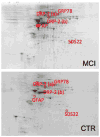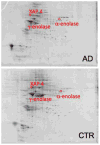Proteomics-determined differences in the concanavalin-A-fractionated proteome of hippocampus and inferior parietal lobule in subjects with Alzheimer's disease and mild cognitive impairment: implications for progression of AD
- PMID: 19072283
- PMCID: PMC2658606
- DOI: 10.1021/pr800667a
Proteomics-determined differences in the concanavalin-A-fractionated proteome of hippocampus and inferior parietal lobule in subjects with Alzheimer's disease and mild cognitive impairment: implications for progression of AD
Abstract
Alzheimer's disease (AD) is the most common type of dementia, comprising 60-80% of all reported cases, and currently affects 5.2 million Americans. AD is characterized pathologically by the accumulation of senile plaques (SPs), neurofibrillary tangles (NFTs), and synapse loss. The early stages of memory loss associated with AD have been studied in a condition known as amnestic mild cognitive impairment (MCI), arguably the earliest form of AD. In spite of extensive research across a variety of disciplines, the cause of AD remains elusive. Proteomics techniques have helped to advance knowledge about AD by identifying irregularities in protein expression and post-translational modifications (PTMs) in AD brain. Glycosylation is a less studied PTM with regards to AD and MCI. This PTM is important to study because glycosylation is involved in proper protein folding, protein anchoring to cell membranes, and the delivery of proteins to organelles, and these processes are impaired in AD. Concanavalin-A (Con-A) binds to N-linked glycoproteins, but hydrophobic sites on nonglycoproteins are also known to bind Con-A. To our knowledge, the present study is the first to examine Con-A-associated brain proteins in MCI and AD with focus on the hippocampus and inferior parietal lobule (IPL) brain regions. Proteins found in AD hippocampus with altered levels are glutamate dehydrogenase (GDH), glial fibrillary acidic protein (GFAP), tropomyosin 3 (TPM3), Rab GDP-dissociation inhibitor XAP-4 (XAP4), and heat shock protein 90 (HSP90). Proteins found with altered levels in AD IPL are alpha-enolase, gamma-enolase, and XAP-4. MCI hippocampal proteins with altered levels are dihydropyrimidase-2 (DRP2), glucose-regulated protein 78 (GRP-78), protein phosphatase related protein Sds-22 (Sds22), and GFAP and the only protein found with altered levels in MCI IPL was beta-synuclein. These results are discussed with reference to biochemical and pathological alterations in and progression of AD.
Figures







Similar articles
-
The wheat germ agglutinin-fractionated proteome of subjects with Alzheimer's disease and mild cognitive impairment hippocampus and inferior parietal lobule: Implications for disease pathogenesis and progression.J Neurosci Res. 2010 Dec;88(16):3566-77. doi: 10.1002/jnr.22528. Epub 2010 Oct 8. J Neurosci Res. 2010. PMID: 20936705
-
Quantitative phosphoproteomic analyses of the inferior parietal lobule from three different pathological stages of Alzheimer's disease.J Alzheimers Dis. 2016;49(1):45-62. doi: 10.3233/JAD-150417. J Alzheimers Dis. 2016. PMID: 26444780
-
Proteomic identification of nitrated brain proteins in early Alzheimer's disease inferior parietal lobule.J Cell Mol Med. 2009 Aug;13(8B):2019-2029. doi: 10.1111/j.1582-4934.2008.00478.x. Epub 2008 Aug 21. J Cell Mol Med. 2009. PMID: 18752637 Free PMC article.
-
Lectin-affinity chromatography brain glycoproteomics and Alzheimer disease: insights into protein alterations consistent with the pathology and progression of this dementing disorder.Proteomics Clin Appl. 2011 Feb;5(1-2):50-6. doi: 10.1002/prca.201000070. Epub 2010 Nov 22. Proteomics Clin Appl. 2011. PMID: 21280237 Review.
-
Oxidatively modified proteins in Alzheimer's disease (AD), mild cognitive impairment and animal models of AD: role of Abeta in pathogenesis.Acta Neuropathol. 2009 Jul;118(1):131-50. doi: 10.1007/s00401-009-0517-0. Epub 2009 Mar 14. Acta Neuropathol. 2009. PMID: 19288120 Free PMC article. Review.
Cited by
-
Characterization of AD-like phenotype in aged APPSwe/PS1dE9 mice.Age (Dordr). 2016 Aug;38(4):303-322. doi: 10.1007/s11357-016-9929-7. Epub 2016 Jul 21. Age (Dordr). 2016. PMID: 27439903 Free PMC article.
-
When Place Matters: Shuttling of Enolase-1 Across Cellular Compartments.Front Cell Dev Biol. 2019 Apr 26;7:61. doi: 10.3389/fcell.2019.00061. eCollection 2019. Front Cell Dev Biol. 2019. PMID: 31106201 Free PMC article. Review.
-
Elusive roles for reactive astrocytes in neurodegenerative diseases.Front Cell Neurosci. 2015 Aug 3;9:278. doi: 10.3389/fncel.2015.00278. eCollection 2015. Front Cell Neurosci. 2015. PMID: 26283915 Free PMC article. Review.
-
Quantitative proteomics analysis of phosphorylated proteins in the hippocampus of Alzheimer's disease subjects.J Proteomics. 2011 Jun 10;74(7):1091-103. doi: 10.1016/j.jprot.2011.03.033. Epub 2011 Apr 13. J Proteomics. 2011. PMID: 21515431 Free PMC article.
-
Proteomic identification of specifically carbonylated brain proteins in APP(NLh)/APP(NLh) × PS-1(P264L)/PS-1(P264L) human double mutant knock-in mice model of Alzheimer disease as a function of age.J Proteomics. 2011 Oct 19;74(11):2430-40. doi: 10.1016/j.jprot.2011.06.015. Epub 2011 Jun 25. J Proteomics. 2011. PMID: 21726674 Free PMC article.
References
-
- 2008 Alzheimer’s disease facts and figures. Alzheimers Dement. 2008;4(2):110–33. - PubMed
-
- Glenner GG, Wong CW. Alzheimer’s disease: initial report of the purification and characterization of a novel cerebrovascular amyloid protein. Biochem Biophys Res Commun. 1984;120(3):885–90. - PubMed
-
- Selkoe DJ. Cell biology of protein misfolding: the examples of Alzheimer’s and Parkinson’s diseases. Nat Cell Biol. 2004;6(11):1054–61. - PubMed
-
- Selkoe DJ. Cell biology of the amyloid beta-protein precursor and the mechanism of Alzheimer’s disease. Annu Rev Cell Biol. 1994;10:373–403. - PubMed
Publication types
MeSH terms
Substances
Grants and funding
LinkOut - more resources
Full Text Sources
Medical
Miscellaneous

